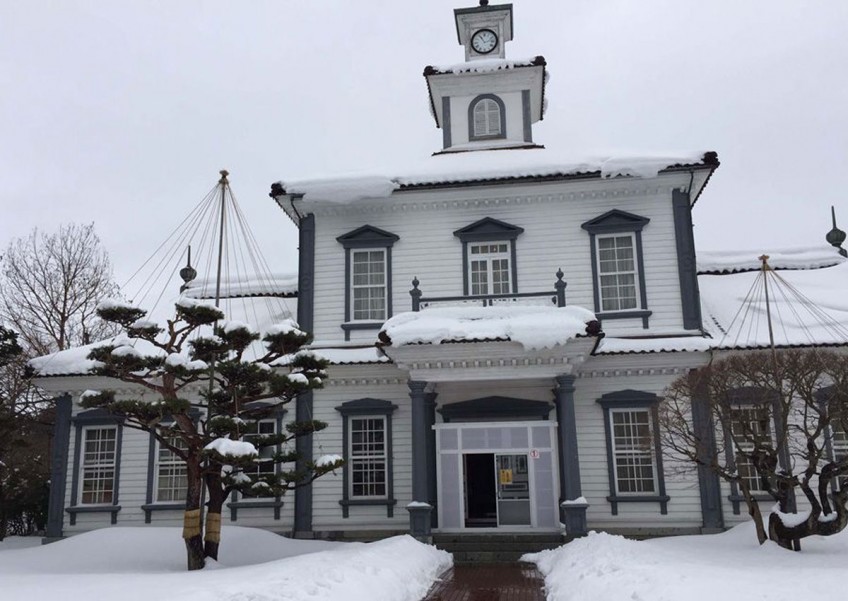Hushed and haunting beauty

You might know Yamagata better than you think especially if you are a fan of the 80's weepie TV drama Oshin (1983-1984) or Yojiro Takita's Oscar-winning Japanese dramedy Departures (2008). Both were shot on location there and often made references to the prefecture's harsh wintery conditions and its isolation.
When we visited Sakata and Tsuruoka cities there last month, the freezing temperatures kept most of its residents in the toasty comfort of their homes. The stillness of the snow-blanketed streets made it look like a ghost town but the sight of a near-empty winter wonderland also added to Yamagata's surreal and haunting beauty.
Its serenity makes perfect sense since the Japanese regard the prefecture - an hour away by air from Tokyo and accessible via Shonai Airport - as the nation's spiritual hub.
For centuries, pilgrims headed to Tsuruoka's Dewa Sanzan (www.dewasanzan.jp) - an area with three sacred mountains: Mounts Gassan, Haguro and Yudono - to practise their Shugendo (a folk religion based on mountain worship, and which mixes Buddhist and Shinto traditions) faith. They believe feats of endurance such as long treks under gruelling conditions can help them transcend the physical world.
The ancient 1.6 km long stone stairway trail from Zuishin Gate to the top of Mount Haguro has become so popular and important it was awarded a three-star rating by the Michelin Green Guide Japan in 2009.
Along the picturesque route lined by towering cedar trees is the 30-metre-tall, 600-year-old Hagurosan Go-Jyu-No-Toh (Five-Storey Pagoda), designated as a national treasure in 1966.
Inside is a giant earthquake-resistant damper pendulum: an incredible feat of architectural engineering back in the day which continues to inspire the design of modern Japanese skyscrapers including the Tokyo Skytree.
At the neighbouring and equally spiritual Sakata City, the Shingon Buddhism Kaikoji Temple (www.kaikouji-sakata.jimdo.com), which is related to the Mount Yudono's Churen Temple, has a pair of flesh-icons - which are the corpses of two abbots who meditated and starved themselves to death during the Edo period - enshrined in the main hall.
This process of self-mummification (sokushinbutsu) has been banned in Japan since 1879 and the temple draws not only its devotees but also curious out-of-towners.
Incidentally, just opposite stands the obata (old-fashioned Japanese restaurant) which was converted into the office of a funeral director for the film Departures. It's one of the port city's most popular tourist attractions but is now closed to the public.
Still, if anybody wants a taste of the local cuisine, all they have to do is head to the 200-year-old Somaro (www.somaro.net) nearby. Previously called Somaya, it was Sakata's most famous restaurant during the Edo period and was known throughout Japan for throwing the best New Year's party. The city's shipping merchants would entertain their clients there but its popularity declined after the second World War and it shut in 1995 before reopening in 2000 as Somaro.
The restaurant now also doubles as a maiko (apprentice geisha) training school and features performances from them which you can enjoy with a seasonal bento meal. The two-storey Somaro also has a museum that traces the history of Sakata.
Similarly, Tsuruoka culture is distilled at the one-stop Chido Museum (www.chido.jp), once part of the Tsurugaoka Castle and home to the Sakai family, a Shonai feudal clan. The theme park-like attraction includes a traditional Japanese farmhouse as well as European-styled residences that have been carefully restored and converted into exhibition spaces featuring artifacts used by the townfolk for fishing as well as battles.
A popular souvenir which Tsuruoka tourists usually cart home is painted candles. They used to be reserved as gifts for the feudal government but have now become a substitute for flowers during the winter months.
At the family-run Togashi Candle Shop (10-52 Sanno-cho Tsuruoka-city, Yamagata), visitors can purchase one off the shelf or partake in painting something themselves.
It's a tranquil experience doing it in this homely mother and daughter-in-law establishment because while the weather outside might be brutally icy, the Yamagata hospitality inside remains warm.

This article was first published on Feb 20, 2016.
Get The Business Times for more stories.